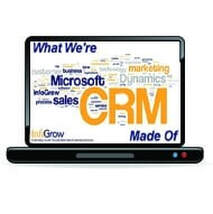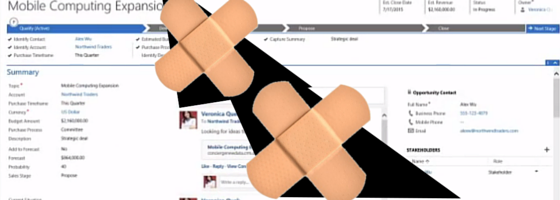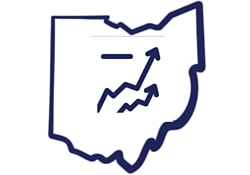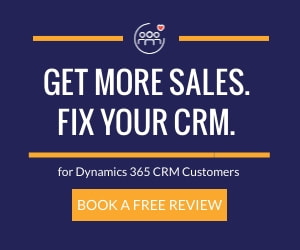See your organization thrive! Improve the customer experience by keeping your sales, marketing
and customer service teams on the same page.
and customer service teams on the same page.
�
|
...if your account managers are following your sales process? No Longer Just a Sales System
CRM software (Customer Relationship Management) has evolved to support organizational business goals across the enterprise; sales, marketing, customer service, relationship building, field service and project management. For non-profits the utilization reaches beyond these areas to include membership management, fundraising, variance in quality, case worker scheduling and volunteer management. A well-implemented Dynamics CRM will focus users on achieving the business goals, both with processes and behaviors monitoring. While a poorly implemented deployment will waste time and money and cause needless frustration for your employees, partners and customers. Why the focus on implementation and not the software? Bob,
We have been so focused on getting Dynamics right for our sales process that we have neglected our service side. What is the best way to bring their calls, request for returns and quality issues, tracked in a separate system, into a company-wide view of the customer? Gabrielle Dear Gabrielle, It’s good you are thinking along the lines that there is value in having one-view of your relationship with a customer. Too often I see account managers needing to chase down customer services issues before a client call, or that service is fixing an old product, or worse yet, a competitive product, that if sales knew they would want to replace Dear Bob, My CFO is asking if our Dynamics CRM deployment was worth the cost. We are in year three of our use of Dynamics and I was not here for the decision to purchase. How do I respond? -- Jack, New Sales Manager Dear Jack,
Since you were not part of the decision process it will be difficult for you collect all of the deployment cost to build your case. I therefore suggest using a combination of the following approaches: Dear Bob, We spend a good deal of resources generate leads for our sales team only to see that the leads are not being followed up. How do I get my CEO to get the sales and manger managers in the same room to make lead follow up a priority? -- Jane Dear Jane, There are two primary reasons that lead follow up doesn’t happen. First, the leads are not what I would call Marketing Qualified. Second, there is not enough vision by the CEO, CSO and CMO into what is happening with leads, or better yet what is not happening. Marketing Qualified Leads Account managers will focus on efforts that put dollars in their pocket. As marketers we must recognize that is a truism. As such, marketing must make any leaded passed on an account manager as qualified. Marketing Qualified means that a lead meets the qualification you have for industry type, size, product and whatever sales has provided you as the top three items that a good lead must contain. And that you have included this information with the lead as well verifying the company name, website, and phone number. Dear Bob, I have a client with an older copy of Goldmine that they just have outgrown. I am afraid to outsource what I don’t know and risk the relationship. -- Mike Dear Mike,
Don’t be afraid to partner. Don’t be afraid to tell your client that CRM is not your specialty, however, you have the capability to bring in someone who is an expert. And together, we can work with you to provide the best possible solution. Change is inevitable – but how do you keep evolving? Leads can come in many ways; website, referral, trade show, direct mail, email drip and even an account rep prospecting. But if we don’t know the sales return from each or the cost of each, how do we evaluate where to invest a limited marketing budget?
Data Silos Bad for Your Clients’ Business -- 9 Reasons to Replace Excel Spreadsheets with CRM6/11/2018
Some B2B companies run their sales and marketing activities with Excel because it is easy to use and well known by employees. However, to more efficiently manage and profitably use data, other B2Bs use a relational-based CRM (Customer Relationship Management). A CRM consists of a database and a user-interface with which you can easily create, update, manage, process, share, and report data across the organization.
While Excel spreadsheets are great calculators, they are not good as a shareable database. That is because, in part, Excel has no relational tables and limited interface capabilities. Excel becomes cumbersome and difficult to manage with thousands of items. I was reminded this week of how much fun this business can be working with clients. As I met with three different clients on their Dynamics Roadmap for the next few quarters, it reminded me of why I am in this business of strengthening customer engagement.
Each of the clients has been with us for some time and each understand the value of CRM to the organization’s profitability and growth. However, it was good to hear that they also view CRM as a tool to strengthen a deeper relationship with their clients for all the various touch points that they have with the client. CRM is a tool to guide existing and new users in their behaviors while getting everyone in marketing, sales and customer service on the same page with the client needs. Experience unprecedented productivity by seeing exactly where your best customers and prospects are located in relation to where you are calling, all without leaving CRM.
InfoGrow recently released its most popular CRM mapping solution with enhanced desktop functionality and new mobile capabilities, enabling account managers to schedule more appointments and make more sales. Here’s the beauty of integrating Dynamics 365 for Sales with a CRM mapping application: raw CRM data comes alive on an interactive map so you can quickly visualize what would have taken hours to analyze in a spreadsheet.
What value does this have for sales reps? It helps them see exactly where their best customers and prospects are located so they can plan more-productive sales trips and close more sales, all without leaving CRM. A Tiered Approach to Dynamics CRM Another way of looking at the issue of overhauling your Dynamics 365 CRM is a three-tiered approach. The first tier is technical. How well is Microsoft CRM actually working in your technical environment? This is often the lowest tier because with most well established CRM systems the technical side is a non-issue overall. However, one spot of concern at this level does linger. How well is Dynamics CRM aligned, technically speaking, with your mobile strategy? Do you have a mobile strategy? Or are your users beating you up to make Microsoft Dynamics CRM work with their tablet or cell phone du jour? I have written before regarding the sales growth value of getting your sales and marketing teams on the same page. This is an effort that can’t be left up to sales or marketing alone, it is too important to the organization and must be monitored at the CEO level.
InsideView does an excellence job in the following infographic to highlight what current leaders are doing to get things right. Point number 6 – “Align on Pipeline” is the element I like the most. By emphasizing the sales pipeline you should expect alignment on lead and nurturing campaigns throughout the sales process. This approach will help drive greater cohesion between both team leaders, as well as provide account reps with advanced insight into the contribution of the marketing team. Microsoft recently acquired Incent Games Inc., the developer and owner of FantasySalesTeam (FST), an innovative sales "gamification" platform that plugs into Dynamics CRM to help companies boost sales productivity. CRM user acceptance among sales teams has always been a challenge. This is especially true dealing with a highly effective senior rep. What benefit does CRM really provide him/her?
Many companies don’t appreciate the value of a CRM system until they understand its pivotal role in closing more sales. CRM’s virtues are not always apparent unless one is intimate with the ins and outs of how business gets done in the organization.
Accurate sales forecasting is essential to growing revenue and managing your business effectively. When you know the timing and amount of incoming revenue, you can plan and focus on the right business initiatives; budget and allocate resources appropriately; set organizational goals; and provide teams with priorities and guidelines for how they spend their time.
Volumes have been written about customer engagement, which is an increasingly vital part of boosting sales, increasing membership, and satisfying both customers and prospects. While successful customer engagement requires a multi-level strategy, it doesn’t have to be complex... just thoughtful and complete.
You’ve seen the ads. The CRM software is free, forever or on a trial basis. Installation takes seconds. Learning takes minutes. Enter some contacts, play around with reports, and voilà! Within hours, everyone is tracking leads, analyzing pipelines, and monitoring customer interaction.
CRM can provide significant benefits to any sales-driven organization that’s focused on customer service. And it can have a profoundly positive impact on internal processes and performance, both individually and organizationally. Despite CRM’s inherent ability to boost profits and deliver insights, there are some things that CRM simply can’t do on its own.
In the state of Ohio, there are roughly 5,000 mid-size businesses in operation, with a mid-market business being defined as an organization that brings in between 10 million and 1 billion dollars in annual revenue. These companies also account for nearly 2 million employed workers statewide, with 74% adding new workers at an average rate of 6.3% in 2014-2015. In comparison, mid-sized businesses nationally only grew their work force by 3.2% - (National Center for the Middle Market.)
Today's CRM (Customer Relationship Management) is better than yesterday's because: (a) CRM systems can now deliver greater productivity returns and (b) vendors' software usability is much improved. These advancements (and others) mean less time and lower costs to implement a CRM system. And the more people in a given company who use a CRM system translates to more benefits and a higher ROI on a CRM investment. Research notes that for every dollar a company invests in a CRM system, it earns $5.60.
|
HOME | SERVICES | SOLUTIONS | BLOG | WHY INFOGROW | CONTACT US |
Address2140 Front Street
Cuyahoga Falls, OH 44221 |
Telephone |
|
© 2024 InfoGrow Corporation















